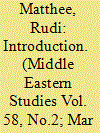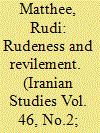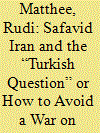|
|
|
Sort Order |
|
|
|
Items / Page
|
|
|
|
|
|
|
| Srl | Item |
| 1 |
ID:
183756


|
|
|
|
|
| Summary/Abstract |
Primarily proscribed for its effect – mind-clouding intoxication – in the Quran, alcohol has nevertheless been consumed in surprisingly large quantities in traditional Islamic culture and society, its lure enhanced by the very rejection it labored under. Drinking was widespread among rulers and elites, from the time of the early Islamic empires, the Umayyads and the Abbasids in the so-called classical age (661-1258), to the early modern ones, the Ottomans in West Asia, the Balkans, and North Africa, the Safavids and the Qajars in Iran, and the Mughals in South Asia. Most sultans and shahs were serious revelers, and booze was inherently part of their carousing. Commoners tended not to imbibe, but to the extent that they did, it was part of a subculture of subterfuge and furtiveness, with men sneaking off to taverns located in back alleys in the non-Muslim quarters of town, dark haunts run by Armenians, Greeks, or Jews.
|
|
|
|
|
|
|
|
|
|
|
|
|
|
|
|
| 2 |
ID:
051137


|
|
|
|
|
| Publication |
Seattle, University of Washington Press, 2002.
|
| Description |
ix, 393p.pbk
|
| Standard Number |
0295982063
|
|
|
|
|
|
|
|
|
|
|
|
Copies: C:1/I:0,R:0,Q:0
Circulation
| Accession# | Call# | Current Location | Status | Policy | Location |
| 046509 | 955/KED 046509 | Main | On Shelf | General | |
|
|
|
|
| 3 |
ID:
120862


|
|
|
|
|
| Publication |
2013.
|
| Summary/Abstract |
This article examines the nature of Iranian-Russian diplomatic relations in the half century after the death of Shah ?Abbas I in 1629, probing the conflicts and mutual interests that prompted the two states to exchange envoys in this period of diminishing high-level contact. In particular, it seeks to reconstruct the Russian mission that visited the court of Shah ?Abbas II in 1664. By all accounts, this mission was treated in a most humiliating way in Isfahan, seemingly in accordance with what outsiders describe the contempt the Iranians felt for Russians. A careful examination of the available sources shows that the poor treatment of its members was due as much to concrete geopolitical concerns and anxieties as to the sense of civilizational superiority the Iranians may have felt vis-à-vis Russians.
|
|
|
|
|
|
|
|
|
|
|
|
|
|
|
|
| 4 |
ID:
168976


|
|
|
|
|
| Summary/Abstract |
This essay parts with the compartmentalized way in which scholarship tends to view Iran’s military predicament in the Safavid era by examining the perennial threat the Ottomans posed to the country largely in isolation from the recurring conflict between the Safavids and their other main adversaries, the Mughals and Uzbeks, respectively. The security dilemma facing Safavid Iran, it is argued here, was acute as well as multifaceted, and should be approached as such. All three of its direct neighbors were Sunni and two, the Ottomans and the Mughals, were capable of mobilizing far greater military resources than Iran. The main strategic concern of the Safavids was to prevent these neighbors from joining forces and engaging them in a two-front war. This study examines balancing the strategies employed by the three most consequential Safavid shahs, Esma‘il I (1501‒24), Tahmasb (1524‒76), and ‘Abbas I (1587‒1629), to avoid becoming the target of a simultaneous or combined assault by their neighbors. This analysis provides the backdrop to the rational decision the Safavids made in 1639—to end the threat of a two-front war by concluding a lasting peace accord with their most formidable enemies, the Ottomans.
|
|
|
|
|
|
|
|
|
|
|
|
|
|
|
|
|
|
|
|
|